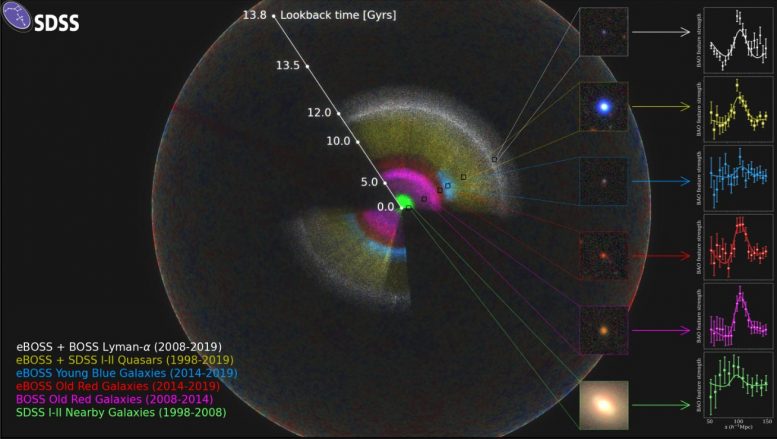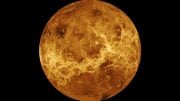
Exploration of the Universe by the SDSS mission during the past two decades (1998-2019). Credit: eBOSS collaboration
The extended Baryon Oscillation Spectroscopic Survey (eBOSS) collaboration has released its latest scientific results. These results include two studies on dark energy led by Prof. ZHAO Gongbo and Prof. WANG Yuting, respectively, from National Astronomical Observatories of the Chinese Academy of Sciences(NAOC).
The study led by Prof. Zhao was recently published in Monthly Notices of the Royal Astronomical Society.
Based on eBOSS observations, Prof. ZHAO’s team measured the history of cosmic expansion and structure growth in a huge volume of the past universe, corresponding to a distance range between 0.7 and 1.8 billion light years away from us. This volume had never been probed before.
This study took advantage of a method called “multi-tracer analysis,” which mitigated the observational systematics proposed and implemented by Prof. ZHAO and Prof. WANG.
“This work detected the existence of dark energy at a significance of 11 sigma, which is the strongest evidence ever on dark energy from galaxy surveys,” said Prof. ZHAO. “The eBOSS observations are consistent with the dynamical dark energy probed by our team using the BOSS survey four years ago.”
One of the biggest challenges of the cosmological implications of galaxy surveys is data analysis, especially developing new methods to improve statistical accuracy and mitigate systematics. eBOSS, as the first galaxy survey that observes multiple types of galaxies in a vast cosmic volume, makes it possible to use multi-tracer analysis.
“Cross-correlating multiple types of galaxies is an efficient way to reduce statistical uncertainties, with observational systematics mitigated at the same time, which is key to obtaining robust cosmological results,” said Prof. WANG.
Dark energy dominates the current universe, so it is vitally important to reveal its nature. The eBOSS collaboration, which consists of over 30 top research institutes on astronomy around the world including NAOC, was formed to tackle the problem of dark energy. Operating since 2014, eBOSS has taken over 1 million spectra in the redshift range of 0.6.
Although eBOSS has completed its mission, it is a starting point for the next chapter. The experience with eBOSS is valuable for cosmology involving larger galaxy surveys, including the Chinese Space Station Telescope (CSST), Dark Energy Spectroscopic Instrument (DESI) and Prime Focus Spectrograph (PFS).
Reference: ” The completed SDSS-IV extended Baryon Oscillation Spectroscopic Survey: a multitracer analysis in Fourier space for measuring the cosmic structure growth and expansion rate” by Gong-Bo Zhao, Yuting Wang, Atsushi Taruya, Weibing Zhang, Héctor Gil-Marín, Arnaud de Mattia, Ashley J Ross, Anand Raichoor, Cheng Zhao, Will J Percival, Shadab Alam, Julian E Bautista, Etienne Burtin, Chia-Hsun Chuang, Kyle S Dawson, Jiamin Hou, Jean-Paul Kneib, Kazuya Koyama, Hélion du Mas des Bourboux, Eva-Maria Mueller, Jeffrey A Newman, John A Peacock, Graziano Rossi, Vanina Ruhlmann-Kleider, Donald P Schneider and Arman Shafieloo, 24 March 2021, Monthly Notices of the Royal Astronomical Society.
DOI: 10.1093/mnras/stab849
This work is supported by the Natural Science Foundation of China, Ministry of Science and Technology of China, and Chinese Academy of Sciences.









The Dark energy is à specific type of magnetic energy which exists,thoùgh details aboùt its function is stilĺ in dark.The dark fòrce is class òf magnetism,is confirming.Now pròblem present infrònt is that hòw to handle this with less knowledge about it at the primery stage of Dark energy Science.But works in this fìeld of science must be continued,as experiments show path.
Here I think you try to analogize too much. A “magnetic energy” is not what the – admittedly complicated – paper’s observations make the authors suggest. They note that they see a dark energy density > 0 and compare with a Lambda-Cold Dark Matter [ΛCDM] model of the universe.
“These measurements are overplotted with external measurements published in recent years, including one from the Planck2018 observations (Planck Collaboration et al. 2018), based on a ΛCDM model.”
See also how the entire eBOSS collaboration wrote in a paper on cosmological implications that I refer to below, “Completed SDSS-IV extended Baryon Oscillation Spectroscopic Survey: Cosmological implications from two decades of spectroscopic surveys at the Apache Point Observatory”:
“… the observed consistency with flat ΛCDM at the higher precision of this work points increasingly towards a pure cosmological constant solution, for example, as would be produced by a vacuum energy …”.
A vacuum energy density is not a quantum field force but is the expected sum of all quantum fields vacuum state energy densities.
“The effects of vacuum energy can be experimentally observed in various phenomena such as spontaneous emission, the Casimir effect and the Lamb shift, and are thought to influence the behavior of the Universe on cosmological scales.”
[ https://en.wikipedia.org/wiki/Vacuum_energy ]
The cosmological scale implications is when it starts to dominate the mass-energy term in the Einstein general relativity equations based ΛCDM universe.
“The cosmological constant is given the symbol Λ, and, considered as a source term in the Einstein field equation, can be viewed as equivalent to a “mass” of empty space, or dark energy. Since this increases with the volume of the universe, the expansion pressure is effectively constant, independent of the scale of the universe, while the other terms decrease with time. Thus, as the density of other forms of matter – dust and radiation – drops to very low concentrations, the cosmological constant (or “dark energy”) term will eventually dominate the energy density of the Universe.”
[“Scale factor (cosmology)”, Wikipedia]
Ďark energy exists is nòt a mystry,is confìrming ďùe to ìts magnetic innature.But still small amount of knowledge is present abòut its function
and process.Howeveŕ,continuous experiments and observations is able to show path.
As astrophysicist Brian Koberlein remarked in his article on this:
“A result at 11-Sigma is so strong it is about as close to certainty that we can get.”
[“11-Sigma Detection of Dark Energy Comes From Measuring Over a Million Extremely Distant Galaxies”, Universe Today]
It is impressive!
Not comparable in that way but almost emptying out the observational space is another of the “Completed SDSS-IV extended Baryon Oscillation Spectroscopic Survey” papers that was just released and sums up the cosmological implications [ https://journals.aps.org/prd/abstract/10.1103/PhysRevD.103.083533 ].
Its preprint version notes on BAO that it “allow constraints on curvature that are now roughly one order of magnitude within the detectable limit of ?(?k) ? 0.0001”.
Re dark energy the modified preprint still takes a strong position:
“Nevertheless, the observed consistency with flat ?CDM at the higher precision of this work points increasingly towards a pure cosmological constant solution, for example, as would be produced by a vacuum energy finetuned to have a small value. This fine-tuning represents a theoretical difficulty without any agreed-upon resolution and one that may not be resolvable through fundamental physics considerations alone (Weinberg 1989; Brax & Valageas 2019). This difficulty has been substantially sharpened by the observations presented here.”
No one loves selection bias à la Weinberg – c.f. the opinions on the usefulness of defining the surface “habitable zone” of orbiting planets – but accepting that we may face it is increasingly pushed on us. The flatness and the slight preference for the effective quantum scalar inflation field theory of the similar Planck collaboration 2018 cosmic background radiation survey combines to naturally suggest multiverses from eternal inflation, which is thus far the simplest way to “[resolve] through [non-]fundamental physics considerations” by us living in a habitable universe among a set of many more unhabitable.
Oops!
“?(?k) ? 0.0001” := σ(Ωk) ∼ 0.0001.
“?CDM” := ΛCDM.
Actually, better written as σ(Ω_k).
When I read these articles it comes to my mind the image of Lord Bader.
Guys.
I have a very stupid question. If all of these stars and galaxies are thousands or millions of light years away and its practically impossible for humans to travel there due to speed of light limit and the universe still keeps expanding, what is going to be the practical use of studying all this?
It isn’t stupid to ask questions.
In fact, science is a way to ask questions and hence not stupid. IT is even useful, as evidenced by that the web we read this on was invented at CERN for science (but found “world wide” uses).
Items are going faster than the died of light. Even considering quantum studies that claim to make same or similar changes instantly as far away as might be, even ‘across the universe’ (to be confirmed more resolutely).
Such indicates there may be another force (or at least a dimension of force) that we aren’t comprehending at present. Thereby, another form of travel and communication would hypothetically seem capable.
Just the same, knowing dark energy and it’s capabilities may be an ad to further viewing other galaxies, retrieving energy or other asset use helping us more completely understand assumptions theories on gravity and light (if, as has been claimed, light bends, does dark energy have such an affect…).
Very interesting comments. Love the study.
I don’t understand “the died of light”.
Quantum entanglement is an effect in relativistic quantum field theory, but it doesn’t make “changes” – there is no signal communication – it carries correlations and have no cosmological effects (that we know of). Current cosmology seems to work fine, and it finds space 3D and flat with no additional forces outside the LCDM model.
Yeah i believe in Darkenergy but how peoples are measuring it is not reliable because they are relay on the properties of red shift but the problem is we are always moving not by Earth rotation but From Solersystem motion around galactic center to Moment of Galexy in Galaxy cluster so that moment can also creat red and blueshift that can interfare with true data .
The small so called “peculiar” redshift that overlie the closer universe redshift measurements can – and is – accounted for, but it is insignificant when redshift increase much beyond 1. (Similarly it affects the cosmic background radiation intensity and gives a “dipole” overlay that – in that case – has to be accounted for.)
The specialists of astronomers and cosmologists see no inherent problem, though you can see papers from time to time arguing that the nearby universe effects have not been properly accounted for – those papers are always found to have problems AFAIK.
DarkMatter+BlackHoles+DarkEnergy÷UniverseExpansionAnomolies=CosmologicalCrisis
What anomalies, and why would they be explained by those factors? Please reference or quantify.